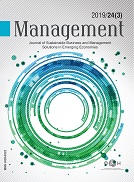Intellectual Capital and Bank Profitability: Evidence from Serbia
DOI:
https://doi.org/10.7595/management.fon.2022.0010Abstract
Research Question: This paper examines how investing in Intellectual Capital (IC) influences bank profitability measured by return on average assets and return on average equity. Motivation: IC is a source of non-physical (added) value for innovative companies in the knowledge-based economy. In finance and banking, efficient use of IC is critical since a bank's capacity to supply high-quality services is based on its investment in IC. As a result, our goal was to throw light on the components of IC and examine how they relate to the commercial bank's financial performance in Serbia. Idea: The main idea behind this paper is to assess the relationship between components of IC and bank profitability. We used the three most common components: Human Capital Efficiency (HCE), Capital Employed Efficiency (CEE), and Structural Capital Efficiency (SCE), as well as control variables such as banks' size and leverage. Data: We used a Bankscope data set that included 27 Serbian commercial banks from 2011 to 2019, with 212 observations. Tools: We used Breusch–Pagan Lagrange multiplier and the Pesaran test to examine cross-section dependence. Based on the test results, we used the system generalized method of moments (GMM) to assess the relationship between IC components and bank profitability. Findings: In Serbian banking industry, both HCE and CEE considerably impact bank profitability. However, we couldn't find evidence that SCE contributes to bank profitability. Contribution: This paper adds to the existing literature on the relationship between IC and bank profitability. However, it also includes a policy recommendation for bank executives as we discovered that investing in IC can positively influence bank profitability.
Downloads
Published
How to Cite
Issue
Section
License
Copyright (c) 2022 Management:Journal of Sustainable Business and Management Solutions in Emerging Economies

This work is licensed under a Creative Commons Attribution-NonCommercial-NoDerivatives 4.0 International License.








